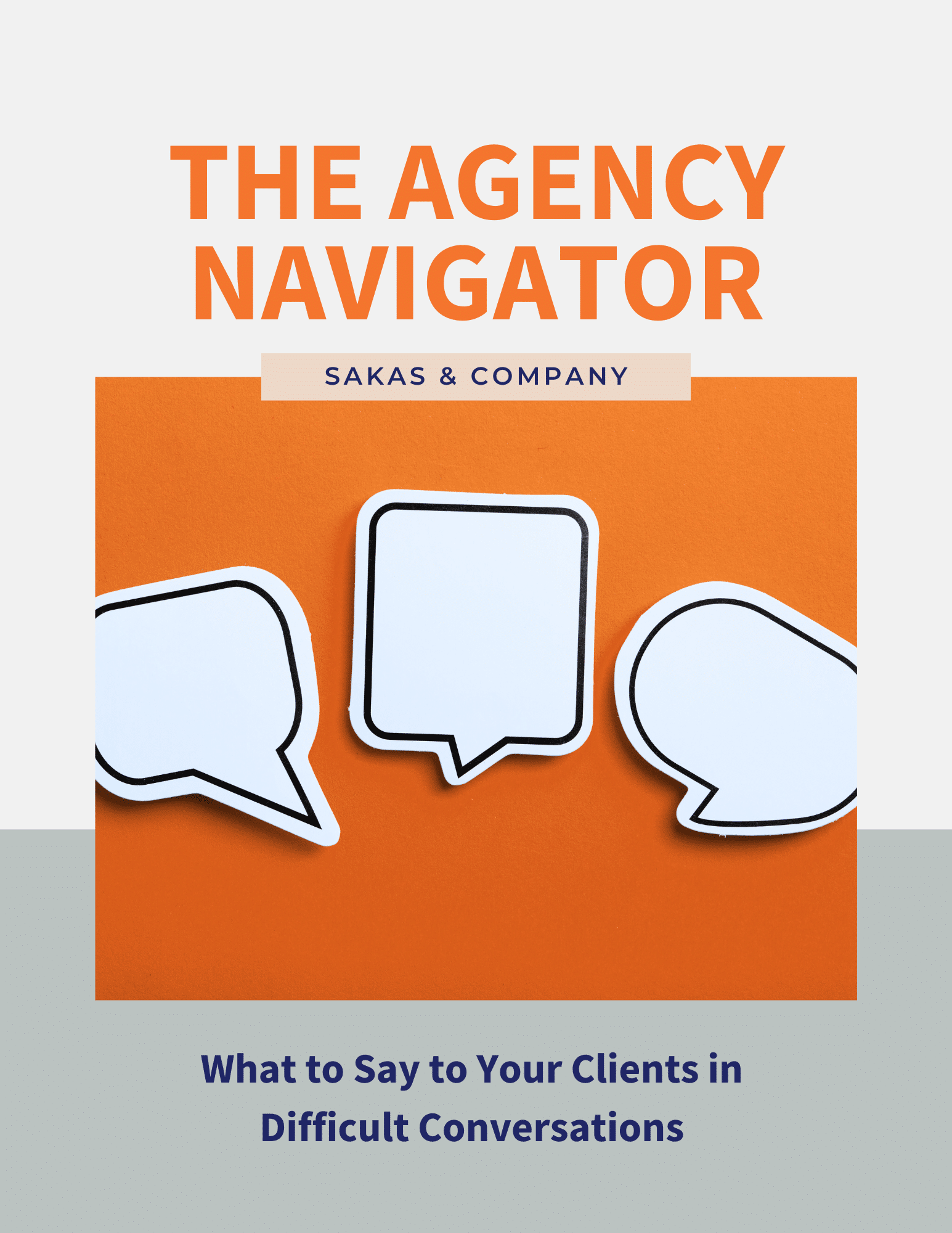A 1:1 consulting client wanted to replicate my boutique client experience, writing “You offer a very boutique experience with handwritten notes, booklets, and attention to detail.”
Based on that, I decided to reverse-engineer my process and share it here, so you can decide if (and how) you want to commit to providing a boutique client experience, too.
Previously, I shared a quiz to help you decide if you currently have a boutique agency. If you scored well, you can use these tips to upgrade your boutique agency experience. And if your score was so-so, this will give you ideas to try.
15 boutique client experience secrets
Here are the 15 points I consider in my process at Sakas & Company. These are primarily 1:1 clients (e.g., doing an Agency Growth Diagnostic project or ongoing Executive Coaching). That is, clients don’t get this level of attentive service after a one-off ActionPath call.
1) Prepare. I always have greeting cards, envelopes, and postage stamps on hand. During my vacation trips to Australia and to Japan, I bought extra stamps to send postcards and other notes. I have a spreadsheet from past mailings, so I don’t need to track down each address individually.
2) Observe. A particular corporation is one of my client’s largest clients. When I checked into my hotel in Melbourne, I noticed the corporation’s Australia headquarters was across the street, so I texted her a “hey!” photo of the building. People like hearing that you’re thinking of them.
3) Plan. I start my latest year-end mailing process in August, sending shipments to arrive around Halloween. I also have my weekly check-in to confirm recent client touchpoints. It looks like magic, but it doesn’t happen magically.
4) Customize. I want clients to feel like they’re my only client. (Within reason, of course; I don’t want people to think I’m at their every beck and call.) For instance, last year’s year-end mailing included a piece with a logo—but it was the client’s logo, not my logo. I also send PR leads (HARO, now SOS) based on a client’s specialization.
5) Remember. My PR agency got me a quote in Digiday, on how agencies are helping clients hire in-house employees. I connected the reporter with a client for an additional quote, who connected the reporter to one of her clients. It was a win-win-win-win-win-win… but it wouldn’t have happened if I hadn’t remembered a key connection from an earlier conversation.
6) Have Physical “Artifacts” to Send. I can send signed copies of my books. I also sometimes have more specific items to send.
7) Budget. Creating a boutique agency experience does require some cash. I spend $1,500 to $2,000 a year on postage. Printing the first edition of the Trends Report booklet was $500. Designing the Trends Report was around $2,000. I’ve commissioned custom illustrations (for my website, book covers, etc.). At volume, my Moo Luxe notecards are $2+ apiece (and totally worth it). Shipping a promotional copy of a book is ~$10-20 apiece (wholesale book, notecard, mailer, postage)—and more when you include labor. And of course, budgeting for year-end mailings.
8) Limit Client Count. I’ll work with 12-15 clients at a time, including projects and ongoing coaching. This eliminates Client Dilution while also avoiding Client Concentration. I couldn’t provide a boutique level of attention if I had 50 active clients. This includes a strategy to wind-down one-off clients.
9) Schedule. I have an Active Client List that I review weekly to ensure I’ve had a recent touchpoint. If I haven’t, I find a reason to reach out—it might be asking about their progress on a deadline they set earlier, asking about how their recent vacation went, or sharing a relevant article. I also auto-tag client emails in Gmail, and review that tag list a few times a week to ensure no one slips through the cracks.
10) Automate. I do several things to help my stay on top of things.
- I use the Boomerang email plugin to bring emails “back” if someone hasn’t responded. Or if someone mentions speaking about something in two months… I Boomerang it, so I can send a message in two months and it looks like magic.
- I use Google Alerts and LinkedIn’s “in the news” to track what’s happening.
- I get the Wall Street Journal—and the Triangle Business Journal to track what’s happening locally in North Carolina.
- My weekly newsletter (Wednesdays and Saturdays), weekly client check-ins (Fridays), and monthly clients-only VIP newsletter (the 1st of each month) give me additional touchpoints.
- My team helps me stay on track.
11) Seek Long-Term. I never stop marketing, but I’ve worked with many of my clients for 5+ years. A majority of my revenue comes from recurring sources, or from returning clients. This means fewer relationships to juggle.
12) Delivery. None of the client service items would work if I weren’t ultimately delivering good work—responsive, high-quality, customized advice. The Warmth & Competence model needs Warmth—but it falls apart without Competence.
13) Caring. This is innate—I care about my clients and their personal and professional success. I don’t expect quite the same level of care (about each client) from my team; that’s partly because my team doesn’t have all the details I get from my regular calls and emails. But I do hire for conscientiousness as a must-have quality. Ultimately—as I elaborate below—this means that “boutique client service” is baked-in, rather than a bolt-on.
14) Connection. I’m connected on Facebook to most of my clients. Some people suggest keeping a sharp separation between work and non-work; beyond obvious boundaries, I don’t think that’s mandatory. This means I can like/comment on things happening in clients’ lives in general. (Not everything, of course, but Facebook’s algorithm helps there.) This is somewhat unique—especially when I do coaching, I’m embedded in the business aspect of clients’ lives. Your clients may choose to be more distant—but the key is letting them choose.
15) Bonuses, Not Expectations. My bonuses do set a high bar for future client experiences, but my goal is to under-promise and over-deliver. For instance, I didn’t promise to send “thinking of you” photos while on vacation in Australia, but I sent several while I was there. To be sure, this sets an ever-higher bar for each subsequent year-end mailing, but that’s not a bad problem when you want to show Warmth & Competence.
Creating a boutique experience must be a core value, not a bolt-on
You can’t delegate 100% of the boutique experience—it ultimately comes from the behavior you model for your team, including where and how you choose to spend your time.
For instance, a client recently asked about how I do my own marketing. I delegate a lot of my marketing, but am highly involved in most of it. (He was disappointed to hear that—he said he was hoping I’d say it was “set it and forget it”!)
On a related note, you need to set an example and engage on boutique-related activities. Automation helps, but some of the examples above require manual work. However, it never feels like too much time to me, because I naturally care about clients. I also know it’s easier (and provides higher ROI) to serve returning clients than to pursue new ones.
Applying This at Your Agency
You have some things to consider before you move forward delivering a boutique experience.
First, do you even want to create a boutique client experience at your agency? If you have more than 25 clients, you probably can’t do it successfully—there are too many clients to juggle, unless you’ve created a pod structure to handle the load.
Second, do you have the team and the structure to make this happen? If you have more than five clients per account manager, it’s going to be tough to deliver—they can’t keep track of each client’s nuances. And 9+ clients apiece? Not going to happen.
Third, are you charging enough to support a boutique experience? If your retainers are $3,000 a month or projects are $7,000 apiece, you can’t currently afford to be boutique; get your positioning and lead-gen down first, to charge more.
Finally, are you willing to do the work it takes to make it happen? As you can see from the list above, it’s not a “set it and forget it” situation—it takes commitment. But I firmly believe the commitment is worth it if you want your agency to be a sustainable business.
If this sounds appealing and you need help handling growing pains at your agency, I’d love to help—please take in touch!
Question: What would it take to create a consistent “boutique agency” experience for your clients?


